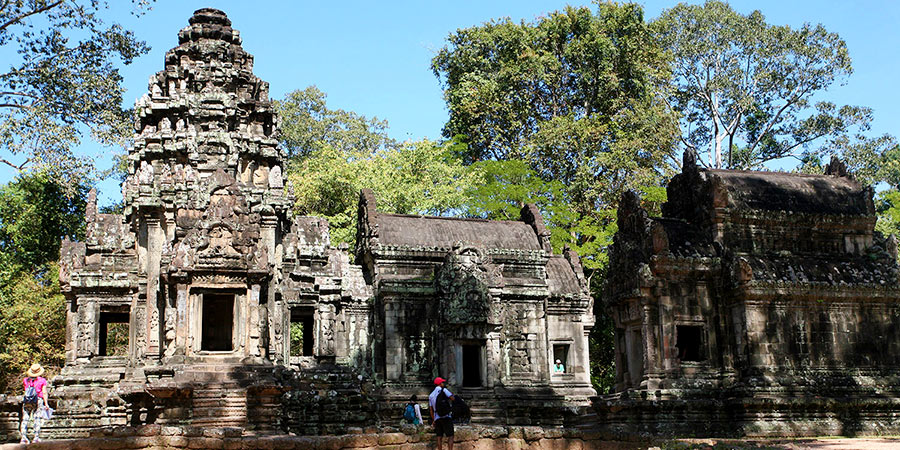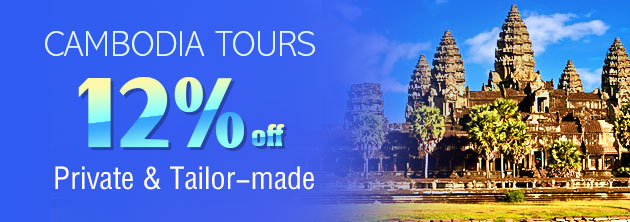Thommanon Temple - Stone Temple with Preserved Carvings
Not all of the temples housed within Cambodia’s Angkor Archaeological Park have undergone extensive restoration. As a result, some of them are only shadows compared to what they once were.However, there are several temples apart from the main Angkor Wat temple that has experienced quality restoration work. These temples are still spectacular to behold, as their structures, sculptures and carvings have been restored to resemble how they were during the glory days of the ancient Angkor Empire.
One such temple is the Thommanon Temple. Known as one of Angkor’s most well-preserved temples, Thommanon should be on your itinerary of places to visit in Cambodia. Here we will discuss all the things that set this particular temple apart from the rest of the monuments, temples and sites in the Angkor Archaeological Park.

Thommanon Temple, Cambodia
|
The Half of a Greater Whole
The construction of the Thommanon Temple was commissioned in the first half of the 12th century when the Angkor Kingdom was ruled by eminent Khmer ruler King Suryavarman II.The extensive work carried out by archaeologists and conservators here has revealed that the temple was constructed at approximately the same time that the legendary Angkor Wat temple complex was built.
The temple was built as half of the greater whole, with the other half being the Chau Say Tevoda Temple. While the Chau Say Tevoda temple only sees a handful of visitors every year, Thommanon experiences high tourist footfall due to the quality of the restoration efforts it has witnessed.
French archaeologists and explorers discovered this once-forgotten temple in the 1960s and wasted little time in starting their restoration efforts, which has resulted in the temple resembling its former self thoroughly.
A Temple Dedicated to Lord Shiva and Lord Vishnu
Lord Vishnu and Lord Shiva are two of Hinduism’s most venerated deities and the Thommanon Temple was built in dedication to them. The temple features sandstone architecture, which had become a common feature of Khmer architecture by the 11th century.Architectural Feats to be Witnessed at Thommanon
The temple boasts of some very distinct architectural features that set it apart from the other temples in the Angkor Archaeological Park. Structurally, the temple has many similarities to the main Angkor Wat temple. However, it still features the following feats of classical Khmer architecture:• A single tower with a central sanctuary that faces east, typical of most temples at Angkor
• The tower or Prasat that crowns the central sanctuary
• The absence of stone-enclosed wooden beams, the presence of which has deterred restoration efforts in the Chau Say Tevoda temple
• Carved pediments that feature on all the doorways
• Sandstone carvings that include carvings of devatas(female figures)in a variety of mudras (gestures) wearing armbands, ankle bands, belts, flower crowns and necklaces
• The sampots (traditional Khmer dress) that display the Bakheng-style ancient pleats that feature in the Phnom Bok and Lolei temples and the Angkor Wat-style patterned and folded fabric
|
|
|
1992: A Landmark Year for Thommanon
The renewed interest in the ancient temples of Angkor brought international attention to Cambodia in the second half of the 20th century. However, it all fell apart when the country was gripped by the terror of civil war and in time, the devastation that the rule of the Khmer Rouge caused.However, the ‘90s saw peace come back to the country and it was in 1992 that Thommanon was given the honor of being a World Heritage Site by UNESCO, propelling tourism to newer heights in the country.
How to Reach the Temple?
From Siem Reap Airport to Angkor Thom, it’s about 9.2 km (5.7 miles). Visitors can take tuk-tuk or taxi to visit Angkor Thom which costs about $20-$30 and $8-$12 per day.Thommanon Temple is located near the eastern entrance to the ancient city of Angkor Thom, you can reach the Thommanon temple from two routes.
The first route involves approaching the temple from Angkor Thom. Simply exit Angkor Thom from the Gate of Victory and follow the road. Take the second turn on the left and you can see the temple after some time.
The second route involves approaching from the temple of Ta Prohm. If you are coming from Ta Prohm, then you should follow the road that leads to the Ta Keo temple. As the road winds right, left and then right again, you should be able to spot the Thommanon temple.
Ticket & Visiting Hours
To explore the temples of Angkor, you need to purchase the Angkor temple pass, which you can do from the ticket counter that is located just in front of the gate of the Angkor Archaeological Park.The ticket prices are as follows:
• $37 for one-day passes• $62 for two-day passes
• $72 for three-day passes
The Angkor Archaeological Park remains open for visitors from 9 AM – 6 PM and you can visit the Thommanon temple at any time during this period.
Best Time to Visit Thommanon
As Thommanon is one of Angkor’s most popular temples, it witnesses a lot of tourists in the winter months, as the winter is Cambodia’s peak tourist season.If you want to experience Thommanon minus the crowds, then the summer and monsoon months make for the best times to visit the temple.
The Thommanon Temple is undoubtedly one of the highlights of the Angkor Archaeological Park. Sure, the temple may not be as big or as grand as the main Angkor Wat Temple and some of the other Angkor Temples. However, it still makes for a must-visit destination in Cambodia if you want to witness the very best of classical Khmer architecture.
Here’s hoping that you have a terrific experience at Thommanon Temple!


